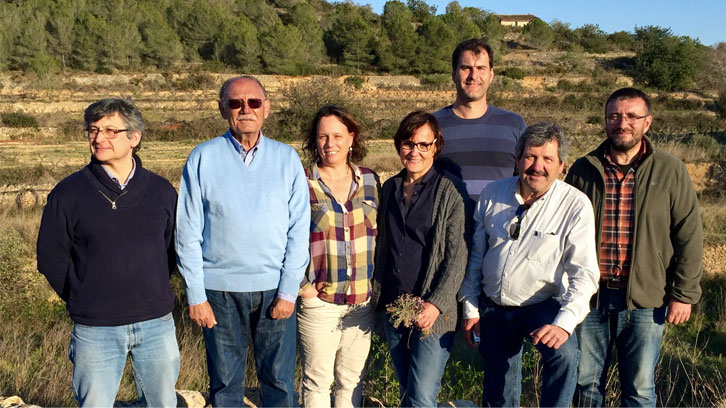Research Group in Agricultural Archaeology of the Middle Ages

The Research Group in Agricultural Archaeology of the Middle Ages (ARAEM) has a line of research that began long ago at the UAB. The aim of study is agricultural areas, farming systems, plants, crop management, and the connection of agriculture with livestock farming and uncultivated areas in medieval societies. Although agrarian history is a field with a long tradition in medievalism, the introduction of an archaeological approach has been little adopted by archaeologists in Spain until recently. The aim is to highlight the need to provide an important space for agricultural landscapes in the study of what is usually called rural population and also in the study of urban networks, whose formation cannot be understood without their surrounding agricultural areas, where farming spaces and specific exchange systems are developed. This means studying human settlements not only from the point of view of the inhabited area but also taking into account agricultural areas, forms of social management and technical choices that these involve.
The objectives of this research group are to exchange, coordinate and contrast research strategies carried out and results obtained in different historiography areas, whose comparison can generate new research perspectives: Andalusi society; pre-feudal and feudal societies of the north of the peninsula; societies resulting from the conquests carried out over al-Andalus and colonial management of Andalusi agricultural areas, as well as the creation of new areas of cultivation. It is also an objective to analyse the impact that these management experiences in areas of conquest have on the organization of agricultural management in overseas colonies.
The agricultural archaeology of the Middle Ages offers a range of methods and techniques that, along with the analysis of written documentation, allow us to investigate these issues. In addition, connections with other research lines help to explain the technical choices made by different societies and in different periods and changes that have taken place. Thus, studies carried out by team members on coinage, architecture archaeology, ceramics, written documentation, feudal conquest and colonization processes, are essential in setting the research group's objectives. These also include maintaining a clear focus on the conservation of landscape heritage.
Most members of the group belong to the UAB Department of Antiquity and Medieval Studies: the current principal investigator of ARAEM group, Helena Kirchner, tenured lecturer; Fèlix Retamero and Antoni Virgili, tenure-track lecturers; Antoni Ferrer and Josep M. Vila, adjunct lecturers and professional archivists and archaeologists; Albert López Mullor, adjunct lecturer and archaeologist at the Heritage Service of Barcelona Provincial Council; Carolina Batet, adjunct lecturer and secondary-school teacher. Jordi Font is a lecturer at the Faculty of Theology of Catalonia and deputy director of the Institute of Liturgy of Barcelona, and finally, Ignacio Díaz Sierra is a PhD student (La Caixa scholarship).
Ongoing projects
In accordance with their lines of research, ARAEM group is conducting the following projects:
Producciones y Espacios Agrarios en Sociedad Ibéricas de la baja Edad Media. Estudios desde la arqueología histórica (siglos XII-XVI).HAR-P 2013-42195, Ministry of Economy and Competitiveness (PIs: Fèlix Retamero, Helena Kirchner).
The aim of this project is to identify, describe and explain the different agricultural practices developed in late-medieval Iberian societies based on case studies located in different spatial and chronological contexts.
Ciudades andalusíes y su entorno agrario y el impacto de la conquista feudal. Los casos de Tortosa y Balaguer(2014/100874), Ministry of Culture (Government of Catalonia) (PI: Helena Kirchner).
The aim of this project is to study, using archaeological methods and analysis of written documentation, Andalusi forms of settlement and agricultural areas around the Andalusi towns of Tortosa and Balaguer, as well as the impact of the feudal conquest of the twelfth century.
Selected publications of the group
KIRCHNER, Helena (ed.). Por una arqueología agraria: perspectivas de investigación sobre espacios de cultivo en las sociedades medievales hispánicas.Oxford: BAR International Series, Archeopress, 2010. ISBN 978-1-4073-0553-0.
KIRCHNER, Helena. Gestion de l’eau et espaces irrigués en Al-Andalus. A HARFOUCHE, R.; POUPET, P. (ed.). Du Mont Liban aux Sierras d'Espagne: sols, eau et sociétés en montagne. Autour du projet franco-libanais CEDRE "Nahr Ibrahim". Oxford: Archaeopress, 2015, p.207-219.
KIRCHNER, Helena; VIRGILI, Antoni; ANTOLÍN, Ferran. Un espacio de cultivo urbano en al-Andalus: Madîna Turṭûša (Tortosa) antes de 1148. Historia Agraria. 2014, vol. 62, p.11-45.
LÓPEZ MULLOR, Albert. La construcción de un método de intervención en el patrimonio arqueológico edificado. Arqueología aplicada al estudio e interpretación de edificios históricos. Últimas tendencias metodológicas. Madrid: Ministerio de Cultura, 2010, p. 65-102.
LÓPEZ MULLOR, Albert. La arqueología medieval en Cataluña, 1980-2010. Boletín de Arqueología Medieval (Asociación Española de Arqueología Medieval). 2011, vol. 15, p.: 265-398.
RETAMERO, Fèlix. La sombra alargada de Wittfogel. A MARÍN, Manuela (ed.). Al-Andalus/España. Historiografías en contraste. Siglos XVII-XXI. Madrid: Casa de Velázquez, 2009, p. 263-293.
RETAMERO, Fèlix; SCHJELLERUP, Inge; DAVIES, Althea (ed.). Agricultural and Pastoral Landscapes in Pre-Industrial Society: Choices, Stability and Change. Oxford and Philadelphia: Oxbow Books, 2016. Earth Series. ISBN 978-1842173596.
VILA, Josep M. Intervenciones arqueológicas en el castillo de Montjuïc. Barcelona. I Jornadas de Patrimonio Defensivo de época Moderna, Figueres 17-20 d'octubre de 2013. Madrid: Ministerio de Defensa, 2014. P. 281-301.
VILA, Josep M. (ed.). Actes del V Congrés d'Arqueologia Medieval i Moderna a Catalunya. Barcelona, 2015.
VIRGILI, Antoni. Angli... cum multis aliis alienigenis. Crusade Settlers in Tortosa (Second Half of the Twelfth Century). Journal of Medieval History. 2009, vol. 35, num. 3, p. 297-312. doi: 10.1016/j.jmedhist.2009.06.002.


